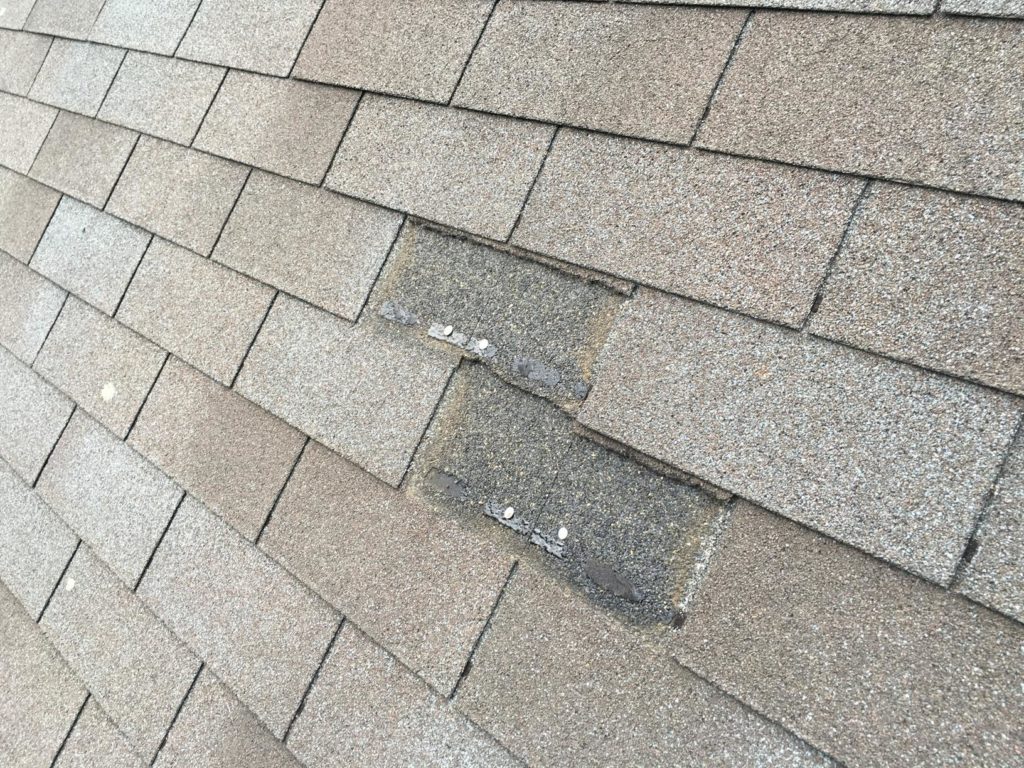Guess what. Not every roof in the Indianapolis area needs to be replaced because it has an issue. Trust Gemini to resolve your roof issue.
Not many roofing contractors will tell you this.
Most say that because you have a roof leak you need to replace your roof. Here’s the gist.
Roof leaks are sometimes complicated. Roof leaks are sometimes easily resolved. Sometimes they’re indicative of a larger issue that means your roof needs to be replaced. Sometimes they just mean that the roofing company that installed your roof may have made a small or big mistake in the roof installation.
These mistakes can frequently be easily fixed. So sometimes a roof repair solves your problem.
Most common types of Indianapolis roof repairs
Missing shingles caused by aging: As a shingled roof ages the adhesion breaks down making the shingles more vulnerable to wind occurrences.

A reputable roof repair company needs to assess the cause of the missing shingles and determine if a repair possible. This mostly is contingent upon the brittleness of the shingles near the missing shingles.
If those shingles are too brittle a repair may not be able to be made without causing more damage.
Missing shingles caused by wind: All shingles are designed to withstand wind gusts and those numbers vary depending on the product and manufacturer.
When your roof starts to lose shingles in wind occurrences you should have a qualified roof contractor inspect and assess whether or not you have an insurable loss from a wind event.
You see the missing shingles but you may not see additional damage which now means every time the wind blows you’ll be missing a couple more shingles.
Missing shingles from installation issues: Sometimes the roofing installer gets it wrong. Installation issues are most commonly caused by over driving nails, erratic nail placement or even cheat nailing (not installing the quantity of nails in a shingle that the manufacturer requires).
When there is an installation issue it usually means the whole roof was installed incorrectly and a repair may not be possible.
Box vent or turtle vent leak: These typically occur because of an installation issue or age. In most situations we can replace these vents or seal them and your problem will be resolved.
Pipe jack leak: The pipes that penetrate out of the field of a roof (PVC pipes, furnace flues, some chimney exhausts) should have a pipe jack at the base of the pipe where it meets the roof. Like a box vent this may have an installation or age issue that typically can be repaired.
Flashing leak: There is a lot of flashing on a roof that you may not see. This is true for a shingled roof, metal roof or flat roof. It’s where a roof meets a wall, dormers and along the sides of a chimney. The most frequent cause of a leak in these areas is from the installation process where the roofing contractor missed a piece of flashing.
Nail pops: Nail pops occur when a roof ages, if a roof was installed over an existing shingled roof or by installation error. When we see a roof that has nail pops it usually means that it’s the start of the problem and more are to come.
Damage: In some instances a roof just gets damaged. If your home or business has trees over the roof limbs can drop down causing a damaged area to leak.
Not all leaks are from your roof
You may see the stain above your head but it may not mean your roof is leaking. There are a lot of infiltration points above most roof lines. Second story windows, siding, wood trims, pipe cracks within the home, masonry on chimneys or walls, chimney caps and clogged gutters are all culprits that can cause leaks inside of a home.
A qualified roofing contractor should be able to diagnose your problem and pinpoint where your leak is originating from.
Ice damming
Does your roof perform well all summer long only to show signs of water infiltration during the winter months? You probably have issues with ice damming which occurs frequently in the Indianapolis area. An ice dam is a ridge of ice that forms at the edge of a roof and prevents melting snow (water) from draining off the roof. The water that backs up behind the dam can leak into a home and cause damage to walls, ceilings, insulation and other areas.
There are things a roofing company can do to minimize this issue, but the fact is that the actual cause of the ice damming has more to do with components of the structure and not just the roof alone.
Contributors to ice damming
Heat loss: This is the main cause of ice damming. When there is snow on the roof and your home is losing heat (inadequate insulation, bath exhaust vents in the attic, chimneys, etc.) the snow will begin to melt. The melted snow flows down to the eave where it freezes and causes a dam.
The new melting snow puddles and freezes behind the dam and can easily work its way into the roofing system and walls. Once the ice starts to melt it may show itself as a leak on the interior.
Design: Some structures make it difficult to help prevent ice damming. Dormers too close together and non-pitched portions of a roof are common examples. If the structure has areas that allow a higher accumulation of snow and it is in an area that is susceptible for heat loss, the design encourages the occurrence of ice damming.
What can a roofer do to help eliminate ice damming?
The problem is easier to address during a roof installation than a roof repair. When installing a new roof you should let the roofing contractor know that you have had previous issues with ice damming in the past. The roofing contractor can do the following:
- Install ice and water shield along the eaves of your home or business. Ice and water shield is different from felt paper. It’s a rubberized membrane that sticks to itself and the wood roof sheathing creating a waterproof barrier to standing water when installed correctly. It may look like traditional felt paper but it’s vastly different in performance. Building codes in the Indianapolis area don’t always require the application of ice and water shield.
- Install gutter apron along the eaves. Gutter apron is a specialized drip edge designed to direct water into the guttering system. Gutter apron is installed into the roof edge and hangs into the gutter.
- Advise you about minimizing your heat loss areas by adding attic insulation to sealing or re-directing bath exhausts.
